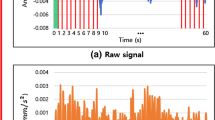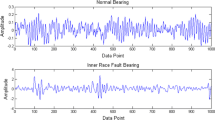Abstract
A new bearing parameter identification methodology based on global optimization scheme using measured unbalance response of rotor–bearing system is proposed. A new hybrid evolutionary algorithm which is a clustering-based hybrid evolutionary algorithm (CHEA), is proposed for global optimization scheme to improve the convergence speed and global search ability. Clustering of individuals by using a neural network is introduced to evaluate the degree of mature of genetic evolution. After clustering-based genetic algorithm (GA), local search is carried out for each cluster to judge the convexity of each cluster. Finally, random search is adapted for extrasearching to find a potential global candidate, which could be missed in GA and local search. The proposed methodology can identify not only unknown bearing parameters but also unbalance information of disk by simply setting them as unknown parameters. Numerical example and experimental results were used to verify the effectiveness of the proposed methodology.
Similar content being viewed by others
References
Assis EG, Steffen Jr V (1999) Multicriterion techniques for the optimization of rotors, in nonlinear dynamics, chaos, control, and their applications to engineering sciences. Vib Meas Control 2:236–249
Assis EG, Steffen Jr V (2003) Inverse problem techniques for the identification of rotor–bearing systems. Inverse Probl Eng 11(1):39–53
Bachschmid N, Pennacchi P, Vania A (2002) Identification of multiple faults in rotor systems. J Sound Vib 254(2):327–366
Berger J, Sassi M, Salois M (1999) A hybrid genetic algorithm for the vehicle routing problem with time windows and itinerary constraints. In: Proceedings of the Genetic and Evolutionary Computation Conference, Orlando, USA, pp 44–51
Burrows CR, Stanway R (1977) Identification of journal bearing characteristics. ASME J Dyn Syst Meas Control 99:167–175
Carpenter GA, Grossberg S (1988) The art of adaptive pattern recognition by a self-organizing neural network. IEEE Trans Comput 21(3):77–88
Chen JH, Lee AC (1995) Estimation of linearized dynamic characteristics of bearings using synchronous response. Int J Mech Sci 37(2):197–219
Chen JH, Lee AC (1997) Identification of linearised dynamic coefficients of rolling element bearings. ASME J Vib Acoust 119:60–69
Choi BG, Yang BS (2000) Optimum shape design of shaft using genetic algorithm. J Vib Control 6(1):207–220
Choi BG, Yang BS (2001a) Multi-objective optimization of rotor–bearing system with dynamic constraints using IGA algorithm. ASME J Eng Gas Turbine Power 123(1):78–81
Choi BG, Yang BS (2001b) Optimal design of rotor–bearing systems using immune-genetic algorithm. ASME J Vib Acoust 123(3):398–401
Conry TF, Goglia PR, Cusano C (1982) A minimum strain energy approach for obtaining optimal unbalance distribution in flexible rotors. J Mech Des 103:875–880
Edwards S, Lees AW, Friswell MI (2000) Experimental identification of excitation and support parameters of a flexible rotor–bearings–foundation system from a single run-down. J Sound Vib 232(5):963–992
Fletcher R (1980) Practical methods of optimization. In: Constrained Optimization. Wiley, New York
Fung RYK, Tang J, Wang D (2002) Extension of a hybrid genetic algorithm for nonlinear programming problems with equality and inequality constrains. Comput Oper Res 29(3):261–274
Goldberg DE (1989) Genetic algorithms in search, optimization, and machine learning. Addison-Wesley, New York
Hageman JA, Wehrens R, van Sprang HA, Buydens LMC (2003) Hybrid genetic algorithm-tabu search approach for optimizing multilayer optical coatings. Anal Chim Acta 490:211–222
Hashimoto H (1997) Optimum design of high-speed, short journal bearings by mathematical programming. Tribol Trans 40:283–293
He D, Li Y, Wang F (2001) Hybrid genetic algorithm based on the operator of pattern search. Inf Control 30(3):276–278
Hsiao CT, Chahine G, Gumerov N (2001) Application of a hybrid genetic algorithm/Powell algorithm and a boundary element method to electrical impedance topography. J Comp Phys 173:433–454
Jiang PL, Yu L (2000) Identification of the oil-film dynamic coefficients in a rotor–bearing system with a hydrodynamic thrust bearing. J Sound Vib 236(4):733–740
Jiang Z, Liu B, Dai L, Wu T (2003) A hybrid genetic algorithm integrated with sequential linear programming. In: Proceedings of the Second International Conference on Machine Learning and Cybernetics, Xian, pp 1030–1033
Kirpatrick SCD, Gelatt MP (1983) Optimization by simulated annealing. Science 220(4598):671–680
Kohonen T (1995) Self-organizing maps. Springer, Berlin Heidelberg New York
Kraus J, Blech JJ, Braun SG (1987) In situ determination of rolling bearing stiffness and damping by modal analysis. ASME J Vib Acoust Stress Reliab Des 109:235–240
Lalanne M, Ferraris G (1998) Rotordynamics prediction in engineering. Wiley, West Sussex, England
Lee CW, Hong SW (1988) Identification of bearing dynamic coefficients by unbalance response measurements. Proc Inst Mech Eng C 203:93–101
Lee CY, Gen M, Kuo W (2001) Reliability optimization design using hybridized genetic algorithm with a neural network technique. IEICE Trans Fundam E84-A(2):627–637
Levin RI, Lieven NAJ (1998) Dynamic finite element model updating using simulated annealing and genetic algorithms. Mech Syst Signal Process 12(1):91–120
Nelson HD (1980) A finite rotating shaft element using Timoshenko beam theory. ASME J Mech Des 102:793–803
Pilkey WD (1994) Formulus for stress, strain, and structural matrices. Wiley, New York, USA
Ponnambalam SG, Reddy MM (2003) A GA–SA multiobjective hybrid search algorithm for integrating lot sizing and sequencing in flow-line scheduling. Int J Adv Manuf Technol 21:126–137
Powell MJD (1978) A fast algorithm for nonlinearly constrained optimization calculations. Numerical analysis. In: Watson GA (ed) Lecture notes in mathematics. Springer, Berlin Heidelberg New York, p 630
Reddy VB, Tiwari R, Kakoty SK (2002) Identification of bearing dynamic parameters from impulse response of rotor bearing systems. Proceedings of VETOMAC-2, December 16–18, BARC, Mumbai, India
Renders JM, Flasse SP (1996) Hybrid methods using genetic algorithms for global optimization. IEEE Trans Syst Man Cybern Part B 26(2):243–258
Roach A, Nagi R (1996) A hybrid GA–SA algorithm for just-in-time scheduling of multi-level assemblies. Comp Ind Eng 30(4):1047–1060
Schittkowski K (1985) NLQPL: a FORTRAN-subroutine solving constrained nonlinear programming problems. Ann Oper Res 5:485–500
Shiau TN, Chang JR (1993) Multi-objective optimization of rotor–bearing system with critical speed constraints. ASME J Eng Gas Turbine Power 115:246–255
Stanway R, Burrows CR, Homes R (1979) Discrete time modeling of squeeze film bearing. J Mech Eng Sci 21(6):419–422
Tiwari R, Lees AW, Friswell MI (2002) Identification of speed-dependent bearing parameters. J Sound Vib 254(5):967–986
Wu Z, Shao H, Wu X (1999) A new adaptive genetic algorithm & its application in multimodal function optimization. Control Theory Appl 16(1):127–129
Yang BS, Han T, An JL (2004) ART–Kohenen neural network for fault diagnosis of rotating machinery. Mech Syst Signal Process 18:645–657
Author information
Authors and Affiliations
Corresponding author
Rights and permissions
About this article
Cite this article
Kim, YH., Yang, BS. & Tan, A.C.C. Bearing parameter identification of rotor–bearing system using clustering-based hybrid evolutionary algorithm. Struct Multidisc Optim 33, 493–506 (2007). https://doi.org/10.1007/s00158-006-0055-5
Received:
Published:
Issue Date:
DOI: https://doi.org/10.1007/s00158-006-0055-5




